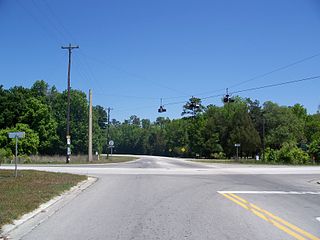
Washington Parish is a parish located in the interior southeast corner of the U.S. state of Louisiana, one of the Florida Parishes. As of the 2020 census, the population was 45,463. Its parish seat is Franklinton. Its largest city is Bogalusa. The parish was founded in 1819.

Crossett is the largest city in Ashley County, Arkansas, United States, with a population of 5,507, according to 2010 Census Bureau estimates. Combined with North Crossett and West Crossett, the population is 10,752. Crossett was incorporated in 1903.

Eros is a town in Jackson Parish, Louisiana, United States. The population was 130 at the 2020 Census It is part of the Ruston Micropolitan Statistical Area.

Bogalusa is a city in Washington Parish, Louisiana, United States. The population was 12,232 at the 2010 census. In the 2020 census the city reported a population of 10,659. It is the principal city of the Bogalusa Micropolitan Statistical Area, which includes all of Washington Parish and is also part of the larger New Orleans–Metairie–Hammond combined statistical area.
Pollok is an unincorporated community in Angelina County, Texas, United States. According to the Handbook of Texas, the community had a population of 300 in 2000. It is located within the Lufkin, Texas micropolitan area.
The Great Southern Lumber Company was chartered in 1902 to harvest and market the virgin longleaf pine forests in southeastern Louisiana and southwestern Mississippi. Bogalusa, Louisiana was developed from the ground up as a company town and was the location for Great Southern Lumber Company's sawmill, which began operation in 1908. Other company interests included a railroad and paper mill. The company ceased operation in 1938, when the supply of virgin pines was depleted. Bogalusa became the site of a paper mill and chemical operations, followed by other industry.
The Grabow riot or Grabow massacre was a violent confrontation that took place between private police hired by management and labor factions in the timber industry near Grabow (Graybow), Louisiana, on July 7, 1912. The clash left three union workers and a company security employee dead, including union leader Asbury Decatur ("Kate") Hall, and an estimated fifty wounded. It was a crucial event in attempts to organize locals and unionize sawmill workers in Louisiana and east Texas in a series of events known as the Louisiana-Texas Lumber War of 1911-1912.
Roy is an unincorporated community located approximately two miles south of Castor in Bienville Parish in northern Louisiana, United States. To the south of Roy is Ashland in Natchitoches Parish. Named for Roy Otis Martin, Sr. (1890-1973), the community was the location of a closed sawmill owned and operated by the Martin Timber Company based in Alexandria, Louisiana, and operated by Martin's son, Roy O. Martin, Jr., and then his grandson, Roy O. Martin, III until sold to Hunt Plywood in 1992.

Gulf Hammock is an unincorporated community in Levy County, Florida, United States. It is near the edge of, and named for, the large wetlands area known as Gulf Hammock. It is located where US 19-98 and County Road 326 cross, near the Wekiva River, approximately 6 miles (9.7 km) southeast of Otter Creek.
Manning is a ghost town in Angelina County, Texas in East Texas, United States. It is located within the Lufkin, Texas micropolitan area.
Alco was a sawmill town in Vernon Parish, Louisiana, United States. It was located on the Red River and Gulf Railroad, 50 miles from Alexandria.
Almadane is an unincorporated community in Vernon Parish, Louisiana, United States. The community is located 3 miles to the south of Evans and 13 miles west of Rosepine on the western edge of Clear Creek Wildlife Management Area on the scenic Myths and Legends Byway.
Peason is a small populated community and sawmill ghost town located on Louisiana highway 118 approximately 8.7 miles (14.0 km) east of Hornbeck, and the sawmill ghost town of Sandel, in Sabine Parish, Louisiana.

William Russell Pickering (1849–1927), referred to as W. R. Pickering, was an American miner, lumber baron, developer, railroad owner and banker. From his first business adventure in mining lead, in Joplin, Missouri in 1872, and his partnership with Ellis Short in the merchandise business at Joplin, the empire grew across several states, including Missouri, Arkansas, Indian Territory, Louisiana, Texas, and California.
Samuel Holmes Fullerton (1852-1939) was an American lumber baron and president as well as vice-president of several companies. He was the founder and president of the Gulf Lumber Company,
The Louisiana and Texas Lumber War of 1911–1912 was a series of worker strikes that fought for better conditions in sawmills in the Piney Woods of west Louisiana and East Texas. These sawmills underwent attempts to unionize that were opposed by lumber companies and owners. The union workers were known as the Brotherhood of Timber Workers (BTW), a branch of the Lumber Workers Industrial Union (LWIU), which was affiliated with the Industrial Workers of the World (IWW). The Brotherhood tried to recruit mill workers by giving speeches and conducting meetings at various mills. Although they had limited success in Louisiana, the LWIU became very successful from 1917 to 1924.
Clawson is an unincorporated community in Angelina County, in the U.S. state of Texas. According to the Handbook of Texas, it had a population of 195 in 2000. It is located within the Lufkin, Texas micropolitan area.

The Elizabeth Hospital Building, at what is now 230 Poplar Street in Elizabeth, Louisiana, was apparently built in 1924.
Oakland, Union Parish, Louisiana is a former community in northern Union Parish, Louisiana, United States. About one mile south of the Arkansas state line, it is 18 miles (29 km) north of Farmerville and 10 miles (16 km) northwest of Marion. It was also known as Union Cross Roads and Springhill or Spring Hill.









